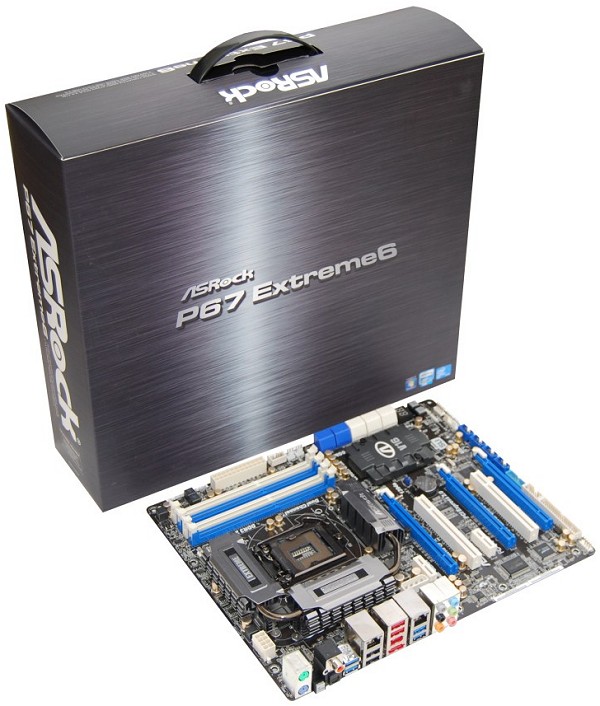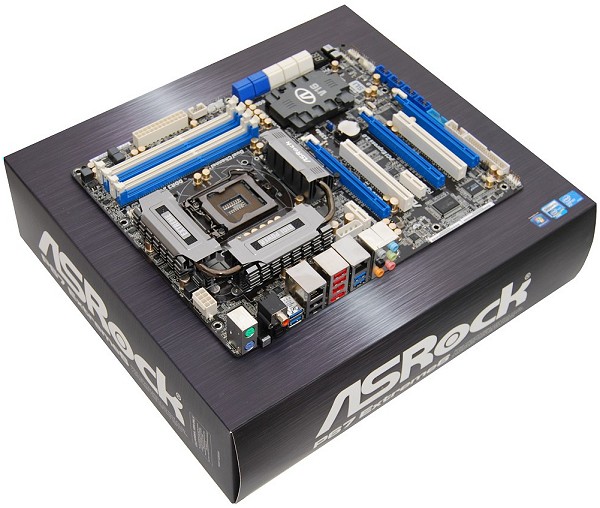Asrock P67 Extreme6 – Features
The P67 Extreme6 is just one of several new Asrock motherboards built to accommodate Intel's LGA1155 processors and it happens to be their highest-end P67 motherboard.

The Asrock P67 Extreme6 feature list includes 64Mb AMI UEFI Legal BIOS with GUI support, six USB 3.0 ports, six SATA3 connectors, 8-channel audio, eSATA3, FireWire and dual-Gigabit LAN with Teaming.

Asrock boasts of the board's premium gold caps (2.5 x longer lifetime) along with 100% Japan-made high-quality conductive polymer capacitors. It also features the Digi Power Advanced V16 + 2 power phase design which is intended to improve the board's overclocking performance.


Asrock has added quite a lot to the standard P67 chipset features. Whereas all P67 motherboards have six SATA 3Gb/s ports (two can work at 6Gb/s speeds) Asrock has expanded the storage capabilities of their P67 Extreme6 by including not one but two Marvell 88SE9120 controllers.
These controllers support a pair of 6Gb/s SATA ports each using a PCI Express 2.0 x1 (5.0Gb/s) lane. The Marvell controllers support NCQ (Native Command Queuing) but they don't have any kind of RAID support, unfortunately. Still the inclusion of these Marvell controllers means that the Asrock P67 Extreme6 features a grand total of ten SATA ports.
Asrock has also expanded the networking capabilities of the P67 Extreme6 by including two Gigabit Ethernet controllers. The dual Realtek RTL8111E controllers each utilize a PCI Express 1.1 x1 (2.0Gb/s) lane and support a wide range of features such as Wake-On-LAN, LAN Cable Detection, Energy Efficient Ethernet 802.3az and Teaming.


Also requiring a PCI Express lanes are three Etron EJ168A controllers, each providing two USB 3.0 ports. Each controller uses a PCI Express 2.0 x1 (5.0Gb/s) lane and supports two USB 1.0/2.0/3.0 devices. Two of these controllers are used to provide four rear USB 3.0 ports while the third controller supports a pair of front mounted ports using an onboard header.

The list of embedded controllers doesn't stop there as Asrock also included the VIA VT6315N IEEE1394 FireWire controller supporting two IEEE 1394a ports with up to 400Mbps data transfer. This also uses a PCI Express 1.1 x1 (2.0Gb/s) lane providing one rear port and one front port using an onboard header.

Asrock has crammed in an enormous amount of PCI Express devices and that presents a problem as the P67 features just eight PCIe 2.0 (5.0Gb/s) lanes, which isn't enough. To solve the issue, Asrock uses a PLX PEX 8608 switch that provides up to eight more flexible ports, though we suspect that many of them have been used to connect the PLX switch to the P67 chip. This is not an ideal solution but it is the only one that allows Asrock to strap on so much extra hardware.

We found that the 8-channel audio is delivered by a rather traditional choice in the Realtek ALC892 codec which supports THX TruStudio Pro. Despite seeing this chipset on numerous Asrock boards before, we were unable to dig up any real info on it. The Realtek website only lists 8-channel codecs from the ALC861 to the ALC889.